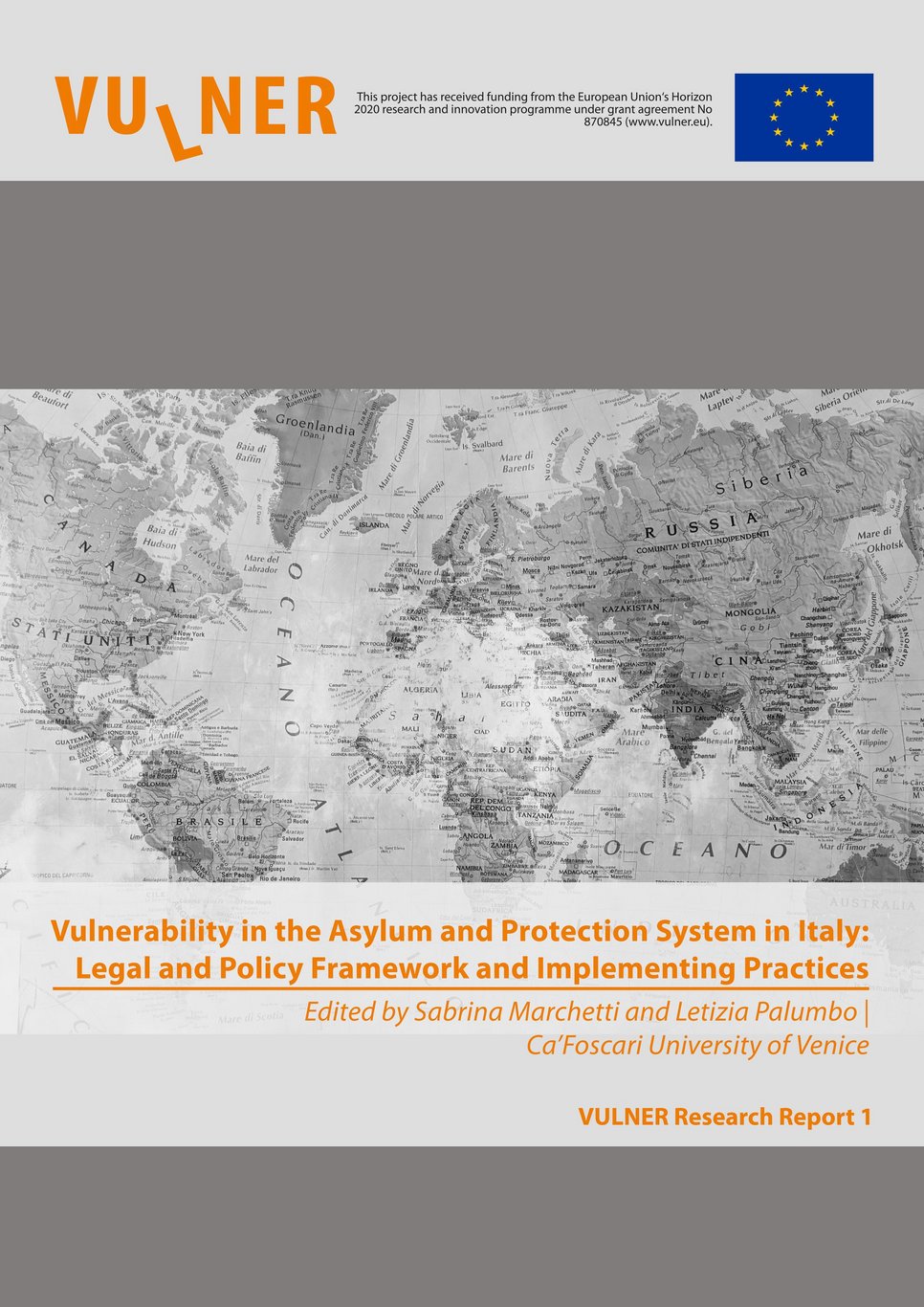Vulnerability in the Asylum and Protection System in Italy
Legal and Policy Framework and Implementing Practices - edited by Sabrina Marchetti and Letizia Palumbo

This research report presents some of the intermediate research results of the VULNER project based on the first phase of the project. This phase consisted of mapping out the vulnerability assessment mechanisms developed by state authorities in Italy, including how they are implemented on the ground through the practices of the public servants in charge.
The following research questions are addressed: What do the relevant domestic legislation, case law, policy documents, and administrative guidelines reveal about how ’vulnerabilities’ are being assessed and addressed in the countries under study? Do the relevant state and/or aid agencies have a legal duty to assess migrants’ vulnerabilities, and if yes, using which procedures, when and how? Following which legal and bureaucratic criteria? How do decision makers (street-level bureaucrats) understand and perceive the ‘vulnerabilities’ of the migrants they meet on a daily basis? How do they address these ‘vulnerabilities’ through their everyday practices? What is their stance on existing legal requirements towards ‘vulnerable’ migrants? What loopholes do they identify?
Sources and data collected
The research for this report was carried out between February and October 2020 and relied on the analysis of the relevant legal and policy framework and case law in the field of migration and asylum, as well as in-depth interviews with key stakeholders.
The report explores how vulnerability is included in asylum procedures as well as in other procedures to obtain a residence permit on humanitarian grounds, the applicant’s situation of vulnerability being a key element considered in granting this form of protection. It is worth noting that, although humanitarian protection was abolished following the Decree Law 113/2018, this form of protection is still being granted to those who applied before the entry into force of the decree Law in 5 October 2018.
The legal documents under analysis include relevant legislation regarding asylum and migration, but also that concerning particular groups, such as victims of trafficking, victims of gender-based violence, and minors, for whom specific protection provisions are foreseen. The report also examines the administrative guidelines and other tools relevant to vulnerability assessments, such as COI (Country of Origin Information), paying specific attention to victims of trafficking, and claims based on mental health problems, sexual orientation, gender identity/expression and sex characteristics (SOGIESC).
With regards to the fieldwork, we conducted forty-four interviews with key actors working in the field of migration and asylum in Italy. Participants to this research included twenty decision makers (one member of the National Commission for the Right of Asylum (CNDA), twelve members/presidents of TCs, six civil tribunal judges, one judge of the Court of Cassation); nineteen lawyers and legal advisors (ten lawyers, nine legal advisors working in NGOs); twelve members of international organizations (UNHCR, EASO, IOM); three other institutional actors; three experts/consultants. Institutional and legal actors involved in the research have been selected taking into account the relevance of their role, expertise, or territory in which they work. The interviewees varied in age and profession, and lived in different regions of Italy.
Key findings
As with the EU CEAS instruments, in Italian asylum and immigration legislation, the definition of vulnerability is not provided per se, but a list of groups considered vulnerable is set out (see Art. 17 of Legislative Decree 142/2015). The same approach can be found in national legislation on trafficking (Decree Law 24/2014). By classifying vulnerabilities into discrete groups, this framing risks overshadowing the contextual dimension of vulnerability.
Guidelines and policy documents produced in recent years by key international organizations working on migration and asylum (UNHCR and IOM) refer to a broad definition of the notion of vulnerability that acknowledges the interaction of situational and individual vulnerabilities. Furthermore, national judicial and administrative decision makers, such as Territorial Commissions (TCs), have paid more attention to the interplay between personal and contextual factors contributing to situations of vulnerability.
However, as the participants to this research stressed, a gendered, sexualized and culturalized conception of vulnerable people/groups is still dominant amongst national institutional actors. This leads not only to those who do not fit into these categories being excluded from protection, but also results in significant aspects of the person’s situations of vulnerability not being taken into account.
According to several lawyers and NGOs members interviewed, credibility as regards experiences and personal characteristics that contribute to migrants’ situations of vulnerability is often assessed by competent authorities through a stereotyped and standardized approach, looking at fragments of the persons’ story in isolation without conducting an overall, integrated assessment of the different factors at stake.
Although institutional tools, such as COI or guidelines, constitute useful instruments in assessing the situations of vulnerability, a number of interviewees criticized the way some of these are used, highlighting that dominant interpretations and paradigms risk downplaying certain vulnerabilities. Others stressed that guidelines need to be frequently updated.
Many participants highlighted how vulnerabilities are produced and/or exacerbated by the country of arrival’s institutional and social context (e.g. inadequate reception system or the lack of non-exploitative working opportunities), including during the asylum procedure (e.g. bureaucratic obstacles and invasive requests in administrative and judicial settings).
Finally we underline how, in contrast with restrictive national legislative and political reforms in the field of migration and asylum, in recent years there have been important case law developments in Italy on the matter of international protection, and humanitarian protection in particular. This case law refers to a broad definition of the notion of vulnerability, paying special attention to its contextual/situational dimension.
Download the full report here.
